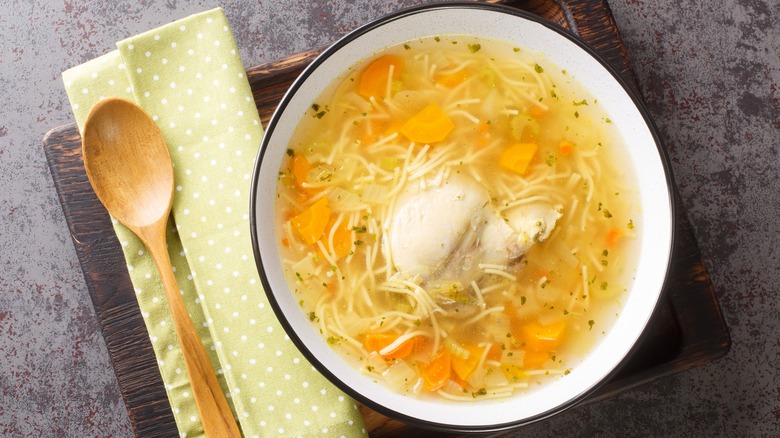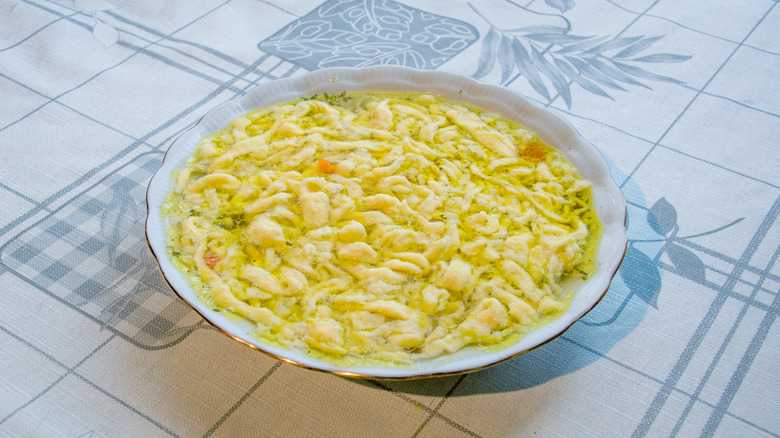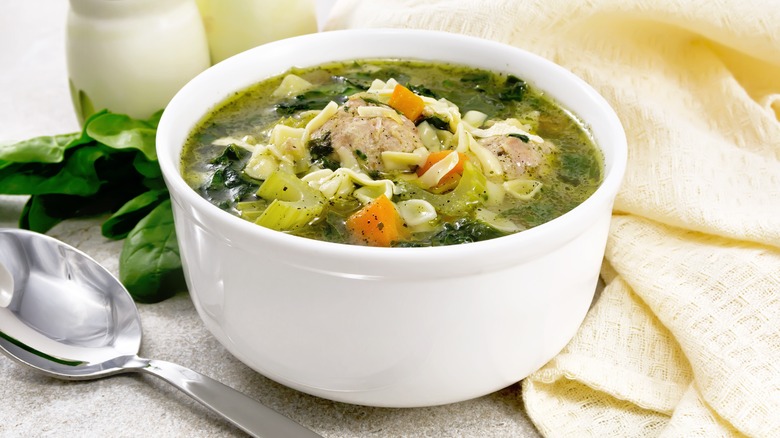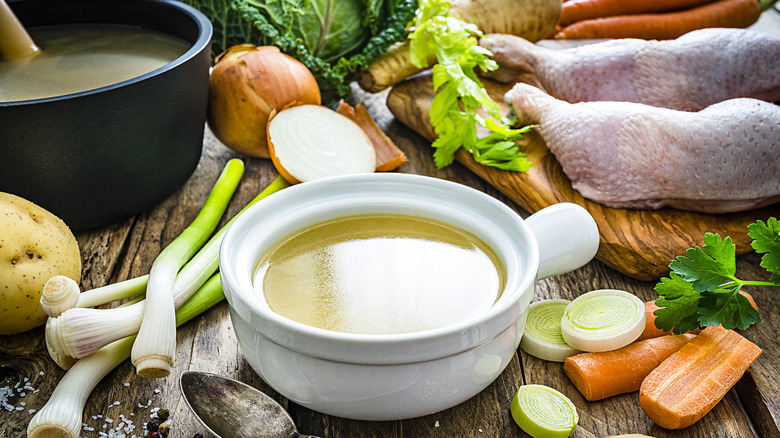5 Chef-Approved Ways To Make Chicken Noodle Soup Restaurant-Worthy
Chicken noodle soup in the metaphorical sense may stand for a panacea, and in a literal sense it can actually be pretty healthy stuff (although the same could be said of any clear broth with meat, vegetables, and pasta). As a taste sensation, though, it very often falls short of even minimal expectations — bland broth plus overcooked noodles equals a big bowl of meh. Even in a restaurant, if you hear that the soup du jour is chicken noodle, you might be likely to say, "No thanks, I'll have the salad instead." There are, however, those rare few restaurants where the chicken noodle soup is something you won't want to miss, and among them is Little Chef Little Cafe in Queens, New York.
In order to get the scoop on the cafe's soup, Mashed spoke with the little chef (and cafe owner) herself, Diana Manalang. While she didn't disclose any top-secret recipes, she did share a number of tips for how to make chicken noodle soup at home that tastes like something you wouldn't skip for a salad. While some of these tips apply to soup made from scratch (like our 20-minute chicken noodle soup), others can be used to doctor up chicken noodle soup that comes out of a can.
These secret ingredients can even boost canned soups
Even if you are eating store-bought chicken noodle soup, there are still a few things you can do to help it taste a bit less bland than it does right out of the can. Diana Manalang lets us in on one ingredient that she likes to use, telling us, "I always add fish sauce to give my canned chicken noodle soup an extra boost of umami."
Fish sauce is a surprisingly versatile condiment, as it turns out, since it can also be used as a secret ingredient in homemade pizza and spaghetti sauce and even replace the Worcestershire sauce in a bloody Mary. One caveat, however: Go easy on the stuff, especially if you're watching your sodium intake, since a single teaspoon contains about ⅓ of the recommended daily maximum amount of this nutrient.
Manalang also has a few other ingredients she likes to use to give her canned soup some Filipino flair, these being ginger and lemongrass. She tells us the flavors are reminiscent of the Filipino chicken-papaya soup called tinola, so she finds these additions "delicious and comforting."
The best chicken soup is made with a meaty mix
Many people, it seems, tend to be pretty partisan about chicken parts. Some swear by thighs and legs, claiming that these are juicier and more flavorful, while others prefer the taste and texture of white meat like breasts and wings. When it comes to making chicken noodle soup, though, Diana Manalang says it's better to mix and match. "For the soup," she tells us, "I like a nice mix of super flavorful dark meat and white meat that stays juicy from being in the broth."
Of course, it's always best to use bone-in chicken if you can. For one thing, it's pretty budget-friendly, since bone-in chicken is usually cheaper than boneless. For another, bone-in chicken tends to be tastier, especially if you keep the skin on since extra fat means extra flavor. As a lagniappe, Manalang points out that the bones themselves can be saved to make stock. (She also hangs onto rotisserie chicken bones for this purpose.)
These noodles are a classic choice
When we asked Diana Manalang what her favorite chicken soup noodles were, she replied, "I always love egg noodles for soup." Numerous other cooks agree — our own copycat Panera chicken noodle soup recipe calls for them, as does our one-pot chicken noodle soup recipe and our slow cooker chicken noodle soup recipe.
Egg noodles, however, aren't de rigueur for chicken soup. As Manalang points out, "Smaller macaroni works well, too." Some of the different types of short and chunky pasta you could use in your soup include penne, rigatoni, farlalle (aka bowties), and shells — in fact, our leftover rotisserie chicken soup recipe is made with this last-named noodle. You could also go with shorter or broken-up rice noodles, which are the kind called for in our roasted corn chicken noodle soup. For a really hearty soup that's practically a one-bowl meal, though, you could even use a filled type of pasta, as we do in our simple chicken tortellini soup. Whichever pasta you pick, you could always make the soup even tastier by toasting the noodles.
Add some green stuff to your soup
Many chicken soup recipes call for carrots and onions, while some make use of potatoes. Diana Manalang, however, suggests going green(s), telling us, "Adding some spinach or kale is a great way to elevate chicken noodle soup."
In fact, you needn't stop there, since you can also experiment with arugula, cabbage, chard, collard greens, endive, escarole, mustard greens, watercress, or any other greens you can get your hands on. If you're experienced with safely foraging, then dandelion greens, nettles, and sorrel can all be used in chicken soup, as well.
Not only will adding greens give your chicken noodle soup some color and a slightly bitter, vegetal flavor, but it will also make it extra-nutritious. Most types of greens are rich in fiber as well as different types of vitamins and minerals. Spinach and kale, for example, have high levels of vitamin K and iron, while collard greens, escarole, and watercress provide plenty of calcium.
Homemade broth is best
Of course, it's better to make your own chicken noodle soup than to doctor up stuff from a can, but it's even better if you can make your own chicken broth, as well. As Diana Manalang tells us, "Using bones, like from the scrap[s] of a rotisserie chicken, to make the stock really gives it such good flavor."
To make a classic chicken stock, take all of the bones and scraps from a chicken and bring them to a boil in a pot of water along with a few vegetables such as carrots and onions. Vegetable scraps and peelings can be used for this purpose, as well, since you'll be straining the stock, so you needn't worry about, say, the papery texture of an onion peel.
The best thing about making your own stock is that you can season it to suit your own taste. Manalang endorses "adding boosts of umami with a few splashes of fish sauce," as she feels this condiment "just makes [the broth] that much better," but if you're not a fish fan, you could employ soy sauce for a similar effect (or tamari, if you're on a gluten-free diet). Our recipe opts for lemon juice to add some tang, while ingredients ranging from white wine to diced habaneros will all work their own kind of flavor magic.





